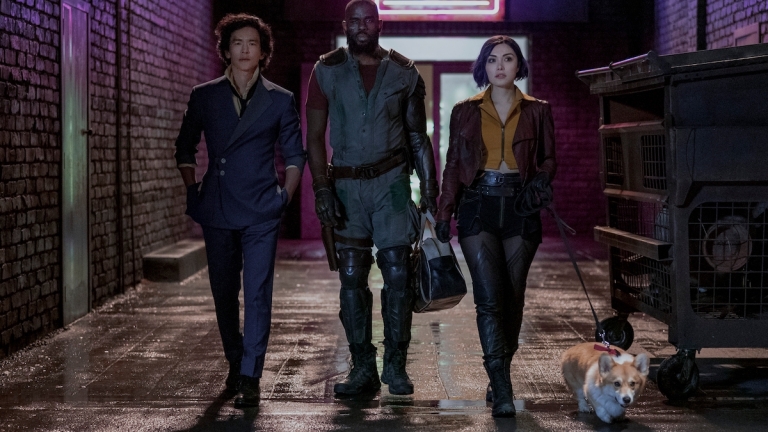‘Cowboy Bebop’ is a surprisingly competent adaptation

“Cowboy Bebop,” the 2021 live-action series reboot of the 1998 anime of the same name, chronicles the story of Spike Spiegel and his bounty-hunting adventures throughout space. Its validity as a reboot may be in question because of the omission of certain characters and storylines diverging throughout the show, developing earlier, later or differently than the 1998 version. Fortunately, much of the original story’s identity remains intact through tongue-in-cheek references and nearly-identical storylines.
Unfortunately, this causes a recurring theme throughout the show. Whenever a scene from the original anime is recreated, it tends to be inferior in execution because of the live-action medium lacking the versatility of animation. Even then, the 2021 adaptation’s original banter and new scenes are great highlights that help expand on aspects the original show never touched on, such as how characters function outside their daily lives as well as their untold backstories.
This paradox for a show hellbent on telling the original story in a new medium is accentuated by how incredible the show’s production value is. Whether it be the sets, clothing or cinematography, everything from a technical standpoint is pretty much unrivaled. I’d be hard-pressed to find another American-made adaptation that had the same level of polish. If I had to imagine a real-life version of these characters, these depictions are about as close as you could get.
The cast bringing these characters to life is an energetic and well-put-together group. Spike Spiegel (John Cho) and Jet Black (Mustafa Shakir) — the characters with the most screen time together — are believable as both friends and co-workers trying to manage their own lives. Scenes depicting the uniqueness of their bond are done quite well as complements to the instances where the duo disagree and leave enough context for the viewer to understand their dynamic.
Other characters such as Faye Valentine (Daniella Pineda), Julia (Elena Satine) and Vicious (Alex Hassell) round out the main cast, interacting with our main two as unintended allies and occasional adversaries.
With writing being a consistent and endemic issue when it comes to recreating shows, “Cowboy Bebop” unfortunately falls into this tangled web. Although at times the series has moments that make you go “Huh, that was pretty alright,” the vast majority of it is either stiff in execution or lacks nuance.
For example, in the first episode, Spike and Jet are searching for a potential bounty in a place called New Tijuana after they busted an earlier bounty. Once they arrive, they find out there were actually two potential marks, as the woman he was traveling with was actually the daughter of a rich man who was attempting to escape. While this interaction was done quite well in the original, the show’s attempt to insert Faye Valentine earlier than the original does not mesh well.
Where the anime had scenes illustrating Spike’s character and his altruistic, selfless philosophy being buried beneath a snarky demeanor and bounty hunting, the live-action iteration removes those components in favor of antagonism between characters that have not been properly developed yet.
With much of the show being a retread of the original, some scenes can feel awkward or misplaced, mostly because of the plot’s reorganization. This reorganization prevents the series from being an effective reflection of the anime’s self-contained plot points. While this occurrence does diminish the plot at times, it does result in some scenes that are actually narratively intriguing and shows the potential competency many want from a show like this.
Whether it be original content or rehashing, the fight choreography is one of “Cowboy Bebop’s” most important aspects. But to put it simply, the show does not meet the mark. Fights in the show are limited by the lack of long-shots displaying action and how bad the actual fighting is.
In the first episode, one of the bounties takes a drug that enhances their fighting ability so he can take on a group of henchmen trying to kill him. The fight begins with the perspective of the character having this red-eyed vision, which is unique and should have been kept as a consistent part. Instead, it switches between that point of view and the third person, diminishing the fight’s value, as the viewer has to jumble between different perspectives that don’t work in sync.
All in all, “Cowboy Bebop” is not that bad for what it is. Most live-action anime shows are downright bad, removing so much from the show’s identity or lacking many of the nuances that helped create the show in the first place. The effort to make the show a worthwhile adaptation, even with its numerous faults, is visible and at times successful. Other times, it can be seen why live-action adaptations can be hit or miss.
In my honest opinion, watch “Cowboy Bebop” if you want an ancillary piece to the original and compare how animes trump their live-action counterparts. If this is your first viewing of the franchise, however, it’s not the worst viewing you could see … but there’s already a better version out there from 23 years ago.
See You, Space Cowboy.

